Selenium Application During Radish (Raphanus sativus) Plant Development Alters Glucosinolate Metabolic Gene Expression and Results in the Production of 4-(methylseleno)but-3-enyl glucosinolate
Abstract
1. Introduction
2. Results
2.1. Liquid Chromatography-Mass Spectrometry (LC-MS) Identification of a New Selenoglucosinolate
2.2. Gas Chromatography-Mass Spectrometry Identification of a New Methylselenoalkyl Isothiocyanate
2.3. Selenium is Accumulated by the Seed of Radish Plants and by Radish Sprouts when Grown under Selenium Supplementation Conditions
2.4. Selenium Supplementation Enabled the Identification of the Selenoglucosinolate, 4-(methylseleno)but-3-enyl Glucosinolate, in Radish Seed and Sprouts
2.5. Selenised GSL Hydrolysis Products are also Found in Radish Seed and Sprouts
2.6. Glucosinolate Content Reduces during Radish Development and is Generally not Affected by Selenium Treatment, except for indol-3-ylmethyl Glucosinolate and 4-methoxyindol-3-ylmethyl Glucosinolate
2.7. Glucosinolate Hydrolysis Products also Decrease during Radish Plant Development, except for the Selenised Forms
2.8. Selenium Treatment Increases the Transcript Abundance of Genes Involved in Indole GSL Production while Decreasing the Transcript Abundance of Genes Involved in Aliphatic GSL Production.
3. Discussion
4. Materials and Methods
4.1. Plant Material and Growth Conditions
4.1.1. Production of Se-enriched Seeds and Sprouts
4.1.2. Production of 5-day-old Sprouts from Control and Se-enriched Radish Seeds
4.1.3. Production of Plant Material for Radish Developmental Series
4.2. Selenium Analysis
4.3. Preparation of Plant Material for Liquid Chromatography-Mass Spectrometry and Gas Chromatography-Mass Spectrometry Analysis
4.4. Analysis of Glucosinolates in Radish Tissues by Liquid Chromatography-Mass Spectrometry
4.5. Analysis of Glucosinolate Hydrolysis Products in Radish Tissues by GC-MS
4.6. RNA Extraction and Quantitative Real Time-Polymerase Chain Reaction (qRT-PCR)
4.7. Statistical Analyses
Supplementary Materials
Author Contributions
Funding
Acknowledgments
Conflicts of Interest
Abbreviations
Appendix A
| Glucosinolate Side Chain | Chemical Name (Abbreviation) | Trivial Name (Abbreviation) |
|---|---|---|
 | 3-(methylthio)propyl-GSL (3MTP) | glucoibervirin (GIB) glucoiberverin |
 | 3-(methylsulfinyl)propyl-GSL (3MSOP) | glucoiberin (GI) |
 | but-3-enyl-GSL (B3) | gluconapin (GNP) |
 | 2-hydroxybut-3-enyl-GSL (2HOB3) | progoitrin (PRO) |
 | 4-(methylthio)but-3-enyl-GSL (4MTB3) | dehydroglucoerucin glucoraphasatin (GRH) |
 | 4-(methylsulfinyl)-GSL but-3-enyl- (4MSOB3) | glucoraphenin (GRE) |
 | 4-(methylthio)butyl-GSL (4MTB) | glucoerucin (GER) |
 | 4-(methylsulfinyl)butyl-GSL (4MSOB) | glucoraphanin (GRA) |
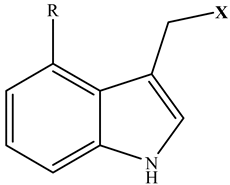 | R = H indol-3-ylmethyl-GSL (I3M) | glucobrassicin (GBS) |
| R = OH 4-hydroxyindol-3-ylmethyl-GSL (4HOI3M) | 4-hydroxyglucobrassicin (4HGBS) | |
| R = OCH3 4-methoxyindol-3-ylmethyl-GSL (4MOI3M) | 4-methoxyglucobrassicin (4MGBS) |
References
- Kryukov, G.V.; Castellano, S.; Novoselov, S.V.; Lobanov, A.V.; Zehtab, O.; Guigo, R.; Gladyshev, V.N. Characterization of Mammalian Selenoproteomes. Science 2003, 300, 1439–1443. [Google Scholar] [CrossRef]
- Sors, T.G.; Ellis, D.R.; Salt, D.E. Selenium uptake, translocation, assimilation and metabolic fate in plants. Photosynth. Res. 2005, 86, 373–389. [Google Scholar] [CrossRef] [PubMed]
- Schiavon, M.; Berto, C.; Malagoli, M.; Trentin, A.; Sambo, P.; Dall’Acqua, S.; Pilon-Smits, E.A.H. Selenium Biofortification in Radish Enhances Nutritional Quality via Accumulation of Methyl-Selenocysteine and Promotion of Transcripts and Metabolites Related to Glucosinolates, Phenolics, and Amino Acids. Front. Plant Sci. 2016, 7, 1371. [Google Scholar] [CrossRef] [PubMed]
- Neuhierl, B.; Böck, A. On the mechanism of selenium tolerance in selenium-accumulating plants—Purification and characterization of a specific selenocysteine methyltransferase from cultured cells of Astragalus bisculatus. Eur. J. Biochem. 1996, 239, 235–238. [Google Scholar] [CrossRef]
- Cai, X.-J.; Block, E.; Uden, P.C.; Zhang, X.; Quimby, B.D.; Sullivan, J.J. Allium chemistry: Identification of selenoamino acids in ordinary and selenium-enriched garlic, onion, and broccoli using gas chromatography with atomic emission detection. J. Agric. Food Chem. 1995, 43, 1754–1757. [Google Scholar] [CrossRef]
- Van Hoewyk, D. A tale of two toxicities: Malformed selenoproteins and oxidative stress both contribute to selenium stress in plants. Ann. Bot. 2013, 112, 965–972. [Google Scholar] [CrossRef]
- Finley, J.W.; Davis, C.D.; Feng, Y. Selenium from high selenium broccoli protects rats from colon cancer. J. Nutr. 2000, 130, 2384–2389. [Google Scholar] [CrossRef]
- Ip, C.; Hayes, C.; Budnick, R.M.; E Ganther, H. Chemical form of selenium, critical metabolites, and cancer prevention. Cancer Res. 1991, 51, 595–600. [Google Scholar]
- Whanger, P.D. Selenocompounds in plants and animals and their biological significance. J. Am. Coll. Nutr. 2002, 21, 223–232. [Google Scholar] [CrossRef]
- Wiesner-Reinhold, M.; Schreiner, M.; Baldermann, S.; Schwarz, D.; Hanschen, F.S.; Kipp, A.P.; Rowan, D.D.; Bentley-Hewitt, K.L.; McKenzie, M.J. Mechanisms of Selenium Enrichment and Measurement in Brassicaceous Vegetables, and Their Application to Human Health. Front. Plant Sci. 2017, 8, 1365. [Google Scholar] [CrossRef]
- Hsu, F.; Wirtz, M.; Heppel, S.C.; Bogs, J.; Krämer, U.T.E.; Khan, M.S.; Bub, A.; Hell, R.; Rausch, T. Generation of Se-fortified broccoli as functional food: Impact of Se fertilization on S metabolism. Plant Cell Environ. 2011, 34, 192–207. [Google Scholar] [CrossRef] [PubMed]
- Trolove, S.N.; Tan, Y.; Morrison, S.C.; Feng, L.; Eason, J. Development of a method for producing selenium-enriched radish sprouts. LWT 2018, 95, 187–192. [Google Scholar] [CrossRef]
- McKenzie, M.; Lill, R.; Trolove, S.; Brummell, D. Biofortification of Fruit and Vegetables with Selenium. Selenium: Chemistry, Analysis, Function and Effects; Royal Society of Chemistry: Cambridge, UK, 2015; pp. 304–323. [Google Scholar]
- Fenwick, G.R.; Heaney, R.K.; Mullin, W.J. Glucosinolates and Their Breakdown Products in Food and Food Plants. CRC Crit. Rev. Food Sci. Nutr. 1983, 18, 123–201. [Google Scholar] [CrossRef]
- Bell, L.; Oloyede, O.O.; Lignou, S.; Wagstaff, C.; Methven, L. Taste and flavor perceptions of glucosinolates, isothiocyanates, and related compounds. Mol. Nutr. Food Res. 2018, 62, 1700990. [Google Scholar] [CrossRef]
- Agerbirk, N.; Olsen, C.E. Glucosinolate structures in evolution. Phytochemistry 2012, 77, 16–45. [Google Scholar] [CrossRef]
- Halkier, B.A.; Gershenzon, J. Biology and biochemistry of glucosinolates. Annu. Rev. Plant Boil. 2006, 57, 303–333. [Google Scholar] [CrossRef]
- Sønderby, I.E.; Geu-Flores, F.; Halkier, B.A. Biosynthesis of glucosinolates–gene discovery and beyond. Trends Plant Sci. 2010, 15, 283–290. [Google Scholar] [CrossRef]
- Rask, L.; Andréasson, E.; Ekbom, B.; Eriksson, S.; Pontoppidan, B.; Meijer, J. Myrosinase: Gene family evolution and herbivore defense in Brassicaceae. Plant Mol. Boil. 2000, 42, 93–114. [Google Scholar] [CrossRef]
- Brader, G.; Mikkelsen, M.D.; Halkier, B.A.; Palva, E.T. Altering glucosinolate profiles modulates disease resistance in plants. Plant J. 2006, 46, 758–767. [Google Scholar] [CrossRef]
- Talalay, P.; Fahey, J.W. Phytochemicals from cruciferous plants protect against cancer by modulating carcinogen metabolism. J. Nutr. 2001, 131, 3027S–3033S. [Google Scholar] [CrossRef]
- Gupta, P.; Kim, B.; Kim, S.-H.; Srivastava, S.K. Molecular targets of isothiocyanates in cancer: Recent advances. Mol. Nutr. Food Res. 2014, 58, 1685–1707. [Google Scholar] [CrossRef] [PubMed]
- Stoner, G.D.; Morse, M.A. Isothiocyanates and plant polyphenols as inhibitors of lung and esophageal cancer. Cancer Lett. 1997, 114, 113–119. [Google Scholar] [CrossRef]
- Andréasson, E.; Jørgensen, L.B.; Höglund, A.-S.; Rask, L.; Meijer, J. Different myrosinase and idioblast distribution in Arabidopsis and Brassica napus. Plant Physiol. 2001, 127, 1750–1763. [Google Scholar] [CrossRef] [PubMed]
- Traka, M.; Mithen, R. Glucosinolates, isothiocyanates and human health. Phytochem. Rev. 2009, 8, 269–282. [Google Scholar] [CrossRef]
- Ávila, F.W.; Yang, Y.; Faquin, V.; Ramos, S.J.; Guilherme, L.R.G.; Thannhauser, T.W.; Li, L. Impact of selenium supply on Se-methylselenocysteine and glucosinolate accumulation in selenium-biofortified Brassica sprouts. Food Chem. 2014, 165, 578–586. [Google Scholar] [CrossRef]
- Robbins, R.J.; Keck, A.-S.; Banuelos, G.; Finley, J.W. Cultivation conditions and selenium fertilization alter the phenolic profile, glucosinolate, and sulforaphane content of broccoli. J. Med. Food 2005, 8, 204–214. [Google Scholar] [CrossRef]
- Charron, C.S.; Kopsell, D.A.; Randle, W.M.; Sams, C.E. Sodium selenate fertilisation increases selenium accumulation and decreases glucosinolate concentration in rapid-cycling Brassica oleracea. J. Sci. Food Agric. 2001, 81, 962–966. [Google Scholar] [CrossRef]
- Matich, A.J.; McKenzie, M.J.; Lill, R.E.; Brummell, D.A.; McGhie, T.K.; Chen, R.K.-Y.; Rowan, D.D. Selenoglucosinolates and their metabolites produced in Brassica spp. fertilised with sodium selenate. Phytochemistry 2012, 75, 140–152. [Google Scholar] [CrossRef]
- Matich, A.J.; McKenzie, M.J.; Lill, R.E.; McGhie, T.K.; Chen, R.K.-Y.; Rowan, D.D. Distribution of selenoglucosinolates and their metabolites in Brassica treated with sodium selenate. J. Agric. Food Chem. 2015, 63, 1896–1905. [Google Scholar] [CrossRef]
- McKenzie, M.J.; Matich, A.J.; Chen, R.K.-Y.; Lill, R.E.; McGhie, T.K.; Rowan, D.D. Identification and distribution of selenium-containing glucosinolate analogues in tissues of three brassicaceae species. In Molecular Physiology and Ecophysiology of Sulfur; Springer: Cham, Switzerland, 2015; pp. 239–246. [Google Scholar]
- Emmert, S.W.; Desai, D.; Amin, S.; Richie, J.P. Enhanced Nrf2-dependent induction of glutathione in mouse embryonic fibroblasts by isoselenocyanate analog of sulforaphane. Bioorg. Med. Chem. Lett. 2010, 20, 2675–2679. [Google Scholar] [CrossRef]
- Ciska, E.; Martyniak-Przybyszewska, B.; Kozlowska, H. Content of glucosinolates in cruciferous vegetables grown at the same site for two years under different climatic conditions. J. Agric. Food Chem. 2000, 48, 2862–2867. [Google Scholar] [CrossRef] [PubMed]
- Visentin, M.; Tava, A.; Iori, R.; Palmieri, S. Isolation and identification for trans-4-(methylthio)-3-butenyl glucosinolate from radish roots (Raphanus sativus L.). J. Agric. Food Chem. 1992, 40, 1687–1691. [Google Scholar] [CrossRef]
- Maldini, M.; Foddai, M.; Natella, F.; Petretto, G.L.; Rourke, J.P.; Chessa, M.; Pintore, G. Identification and quantification of glucosinolates in different tissues of Raphanus raphanistrum by liquid chromatography tandem-mass spectrometry. J. Food Compos. Anal. 2017, 61, 20–27. [Google Scholar] [CrossRef]
- Montaut, S.; Barillari, J.; Iori, R.; Rollin, P. Glucoraphasatin: Chemistry, occurrence, and biological properties. Phytochemistry 2010, 71, 6–12. [Google Scholar] [CrossRef] [PubMed]
- Cataldi, T.R.I.; Lelario, F.; Orlando, D.; Bufo, S.A. Collision-Induced Dissociation of the A + 2 Isotope Ion. Facilitates Glucosinolates Structure Elucidation by Electrospray Ionization-Tandem Mass Spectrometry with a Linear Quadrupole Ion. Trap. Anal. Chem. 2010, 82, 5686–5696. [Google Scholar] [CrossRef]
- Clarke, D.B. Glucosinolates, structures and analysis in food. Anal. Methods 2010, 2, 310–325. [Google Scholar] [CrossRef]
- Friis, P.; Kjær, A. 4-Methylthio-3-butenyl isothiocyanate, the pungent principle of radish root. Acta Chem. Scand. 1966, 20, 698–705. [Google Scholar] [CrossRef]
- Kjaer, A.; Ohashi, M.; Wilson, J.M.; Djerassi, C. Mass spectra of isothiocyanates. Acta Chem. Scand. 1963, 17, 2143–2154. [Google Scholar] [CrossRef]
- Jensen, K.A.; Holm, A.; Wentrup, C. Alkyl cyanates. VII. Mass spectra of cyanates. Acta Chem. Scand. 1966, 20, 2107–2122. [Google Scholar] [CrossRef]
- Cole, R.A. Isothiocyanates, nitriles and thiocyanates as products of autolysis of glucosinolates in Cruciferae. Phytochemistry 1976, 15, 759–762. [Google Scholar] [CrossRef]
- Smrkolj, P.; Osvald, M.; Osvald, J.; Stibilj, V. Selenium uptake and species distribution in selenium-enriched bean (Phaseolus vulgaris L.) seeds obtained by two different cultivations. Eur. Food Res. Technol. 2007, 225, 233–237. [Google Scholar] [CrossRef]
- Stibilj, V.; Kreft, I.; Smrkolj, P.; Osvald, J. Enhanced selenium content in buckwheat (Fagopyrum esculentum Moench) and pumpkin (Cucurbita pepo L.) seeds by foliar fertilisation. Eur. Food Res. Technol. 2004, 219, 142–144. [Google Scholar] [CrossRef]
- Wang, Y.-D.; Wang, X.; Ngai, S.-M.; Wong, Y.-S. Comparative Proteomics Analysis of Selenium Responses in Selenium-Enriched Rice Grains. J. Proteome Res. 2013, 12, 808–820. [Google Scholar] [CrossRef] [PubMed]
- Bañuelos, G.S.; Hanson, B.D. Use of Selenium-enriched Mustard and Canola Seed Meals as Potential Bioherbicides and Green Fertilizer in Strawberry Production. HortScience 2010, 45, 1567–1572. [Google Scholar] [CrossRef]
- Bañuelos, G.S.; Walse, S.S.; Yang, S.I.; Pickering, I.J.; Fakra, S.C.; Marcus, M.A.; Freeman, J.L. Quantification, Localization, and Speciation of Selenium in Seeds of Canola and Two Mustard Species Compared to Seed-Meals Produced by Hydraulic Press. Anal. Chem. 2012, 84, 6024–6030. [Google Scholar] [CrossRef]
- Jaiswal, S.K.; Prakash, R.; Acharya, R.; Reddy, A.V.; Prakash, N.T. Selenium content in seed, oil and oil cake of Se hyperaccumulated Brassica juncea (Indian mustard) cultivated in a seleniferous region of India. Food Chem. 2012, 134, 401–404. [Google Scholar] [CrossRef]
- Seppänen, M.M.; Kontturi, J.; Heras, I.L.; Madrid, Y.; Cámara, C.; Hartikainen, H. Agronomic biofortification of Brassica with selenium–enrichment of SeMet and its identification in Brassica seeds and meal. Plant Soil 2010, 337, 273–283. [Google Scholar] [CrossRef]
- Ciska, E.; Honke, J.; Kozłowska, H. Effect of light conditions on the contents of glucosinolates in germinating seeds of white mustard, red radish, white radish, and rapeseed. J. Agric. Food Chem. 2008, 56, 9087–9093. [Google Scholar] [CrossRef]
- Daxenbichler, M.E.; Spencer, G.F.; Carlson, D.G.; Rose, G.B.; Brinker, A.M.; Powell, R.G. Glucosinolate composition of seeds from 297 species of wild plants. Phytochemistry 1991, 30, 2623–2638. [Google Scholar] [CrossRef]
- Barillari, J.; Cervellati, R.; Paolini, M.; Tatibouët, A.; Rollin, P.; Iori, R. Isolation of 4-methylthio-3-butenyl glucosinolate from Raphanus sativus sprouts (kaiware daikon) and its redox properties. J. Agric. Food Chem. 2005, 53, 9890–9896. [Google Scholar] [CrossRef]
- Gu, E.-H.; Su’Udi, M.; Han, N.; Kwon, B.; Lim, S.; Kim, J. Increase in aliphatic glucosinolates synthesis during early seedling growth and insect herbivory in radish (Raphanus sativus L.) plant. Hortic. Environ. Biotechnol. 2015, 56, 255–262. [Google Scholar] [CrossRef]
- Wang, J.; Qiu, Y.; Wang, X.; Yue, Z.; Yang, X.; Chen, X.; Zhang, X.; Shen, D.; Wang, H.; Song, J.; et al. Insights into the species-specific metabolic engineering of glucosinolates in radish (Raphanus sativus L.) based on comparative genomic analysis. Sci. Rep. 2017, 7, 16040. [Google Scholar] [CrossRef] [PubMed]
- Nour-Eldin, H.H.; Halkier, B.A. Piecing together the transport pathway of aliphatic glucosinolates. Phytochem. Rev. 2009, 8, 53–67. [Google Scholar] [CrossRef]
- Nour-Eldin, H.H.; Andersen, T.G.; Burow, M.; Madsen, S.R.; Jørgensen, M.E.; Olsen, C.E.; Dreyer, I.; Hedrich, R.; Geiger, D.; Halkier, B.A. NRT/PTR transporters are essential for translocation of glucosinolate defence compounds to seeds. Nature 2012, 488, 531–534. [Google Scholar] [CrossRef]
- Fahey, J.W.; Zhang, Y.S.; Talalay, P. Broccoli sprouts: An exceptionally rich source of inducers of enzymes that protect against chemical carcinogens. Proc. Natl. Acad. Sci. USA 1997, 94, 10367–10372. [Google Scholar] [CrossRef]
- Bennett, R.N.; Kiddle, G.; Wallsgrove, R.M. Involvement of cytochrome P450 in glucosinolate biosynthesis in white mustard—A biochemical anomaly. Plant Physiol. 1997, 114, 1283–1291. [Google Scholar] [CrossRef]
- Lykkesfeldt, J.; Moller, B.L. Synthesis of Benzylglucosinolate in Tropaeolum-Majus L—Isothiocyanates as Potent Enzyme-Inhibitors. Plant Physiol. 1993, 102, 609–613. [Google Scholar] [CrossRef]
- Gorissen, A.; Kraut, N.U.; De Visser, R.; De Vries, M.; Roelofsen, H.; Vonk, R.J. No de novo sulforaphane biosynthesis in broccoli seedlings. Food Chem. 2011, 127, 192–196. [Google Scholar] [CrossRef]
- Borş, M.D.; Semeniuc, C.A.; Socaci, S.; Vârva, L.; Moldovan, O.; Vlaic, R.; Tofană, M. Total phenolic content and antioxidant capacity of radish as influenced by the variety and vegetative stage. Bull. UASVM Food Sci. Technol. 2015, 72, 77–81. [Google Scholar] [CrossRef]
- Blum, T.; Ermert, J.; Coenen, H.H. Synthesis of asymmetric [75Se] selenoethers via carbodiimides. J. Label. Compd. Radiopharm. 2001, 44, 587–601. [Google Scholar] [CrossRef]
- Hanlon, P.R.; Barnes, D.M. Phytochemical Composition and Biological Activity of 8 Varieties of Radish (Raphanus sativus L.) Sprouts and Mature Taproots. J. Food Sci. 2011, 76, 185–192. [Google Scholar] [CrossRef]
- Cierpiał, T.; Łuczak, J.; Kwiatkowska, M.; Kiełbasiński, P.; Mielczarek, L.; Wiktorska, K.; Chilmonczyk, Z.; Milczarek, M.; Karwowska, K. Organofluorine isoselenocyanate analogues of sulforaphane: Synthesis and anticancer activity. ChemMedChem 2016, 11, 2398–2409. [Google Scholar] [CrossRef] [PubMed]
- Chen, S.X.; Glawischnig, E.; Jørgensen, K.; Naur, P.; Jørgensen, B.; Olsen, C.E.; Hansen, C.H.; Rasmussen, H.; Pickett, J.A.; Halkier, B.A. CYP79F1 and CYP79F2 have distinct functions in the biosynthesis of aliphatic glucosinolates in Arabidopsis. Plant J. 2003, 33, 923–937. [Google Scholar] [CrossRef] [PubMed]
- Mikkelsen, M.D.; Hansen, C.H.; Wittstock, U.; Halkier, B. Cytochrome P450 CYP79B2 from Arabidopsis catalyzes the conversion of tryptophan to indole-3-acetaldoxime, a precursor of indole glucosinolates and indole-3-acetic acid. J. Biol. Chem. 2000, 275, 33712–33717. [Google Scholar] [CrossRef] [PubMed]
- Bak, S.; Tax, F.E.; Feldmann, K.A.; Galbraith, D.W.; Feyereisen, R. CYP83B1, a cytochrome P450 at the metabolic branch point in auxin and indole glucosinolate biosynthesis in Arabidopsis. Plant Cell 2001, 13, 101–111. [Google Scholar] [CrossRef] [PubMed]
- Kopriva, S.; Mugford, S.G.; Baraniecka, P.; Lee, B.-R.; Matthewman, C.A.; Koprivova, A. Control of sulfur partitioning between primary and secondary metabolism in Arabidopsis. Front. Plant Sci. 2012, 3, 163. [Google Scholar] [CrossRef]
- McKenzie, M.J.; Chen, R.K.; Leung, S.; Joshi, S.; Rippon, P.E.; Joyce, N.I.; McManus, M.T. Selenium treatment differentially affects sulfur metabolism in high and low glucosinolate producing cultivars of broccoli (Brassica oleracea L.). Plant Physiol. Biochem. 2017, 121, 176–186. [Google Scholar] [CrossRef]
- Zayed, A.; Lytle, C.M.; Terry, N. Accumulation and volatilization of different chemical species of selenium by plants. Planta 1998, 206, 284–292. [Google Scholar] [CrossRef]
- Lyi, S.M.; Heller, L.I.; Rutzke, M.; Welch, R.M.; Kochian, L.V.; Li, L. Molecular and biochemical characterization of the selenocysteine Se-methyltransferase gene and Se-methylselenocysteine synthesis in broccoli. Plant Physiol. 2005, 138, 409–420. [Google Scholar] [CrossRef]
- Hanlon, P.R.; Webber, D.M.; Barnes, D.M. Aqueous extract from spanish black radish (Raphanus sativus L. Var. niger) induces detoxification enzymes in the HepG2 human hepatoma cell line. J. Agric. Food Chem. 2007, 55, 6439–6446. [Google Scholar] [CrossRef]
- Papi, A.; Orlandi, M.; Bartolini, G.; Barillari, J.; Iori, R.; Paolini, M.; Ferroni, F.; Grazia Fumo, M.; Pedulli, G.F.; Valgimigli, L. Cytotoxic and antioxidant activity of 4-methylthio-3-butenyl isothiocyanate from Raphanus sativus L. (Kaiware daikon) sprouts. J. Agric. Food Chem. 2008, 56, 875–883. [Google Scholar] [CrossRef] [PubMed]
- Scholl, C.; Eshelman, B.D.; Barnes, D.M.; Hanlon, P.R. Raphasatin Is a More Potent Inducer of the Detoxification Enzymes Than Its Degradation Products. J. Food Sci. 2011, 76, C504–C511. [Google Scholar] [CrossRef]
- Benton Jones, J., Jr. A Guide for the Hydroponic & Soilless Culture Growers; Timber Press: Portland, OR, USA, 1983. [Google Scholar]
- Anderson, K. Micro-digestion and ICP-AES analysis for the determination of macro and micro elements in plant tissues. At. Spectrosc. 1996, 17, 30–33. [Google Scholar]
- Esfandiari, A.; Saei, A.; McKenzie, M.J.; Matich, A.J.; Babalar, M.; Hunter, D.A. Preferentially enhancing anti-cancer isothiocyanates over glucosinolates in broccoli sprouts: How NaCl and salicylic acid affect their formation. Plant Physiol. Biochem. 2017, 115, 343–353. [Google Scholar] [CrossRef]
- Livak, K.J.; Schmittgen, T.D. Analysis of relative gene expression data using real-time quantitative PCR and the 2−ΔΔCt method. Methods 2001, 25, 402–408. [Google Scholar] [CrossRef]
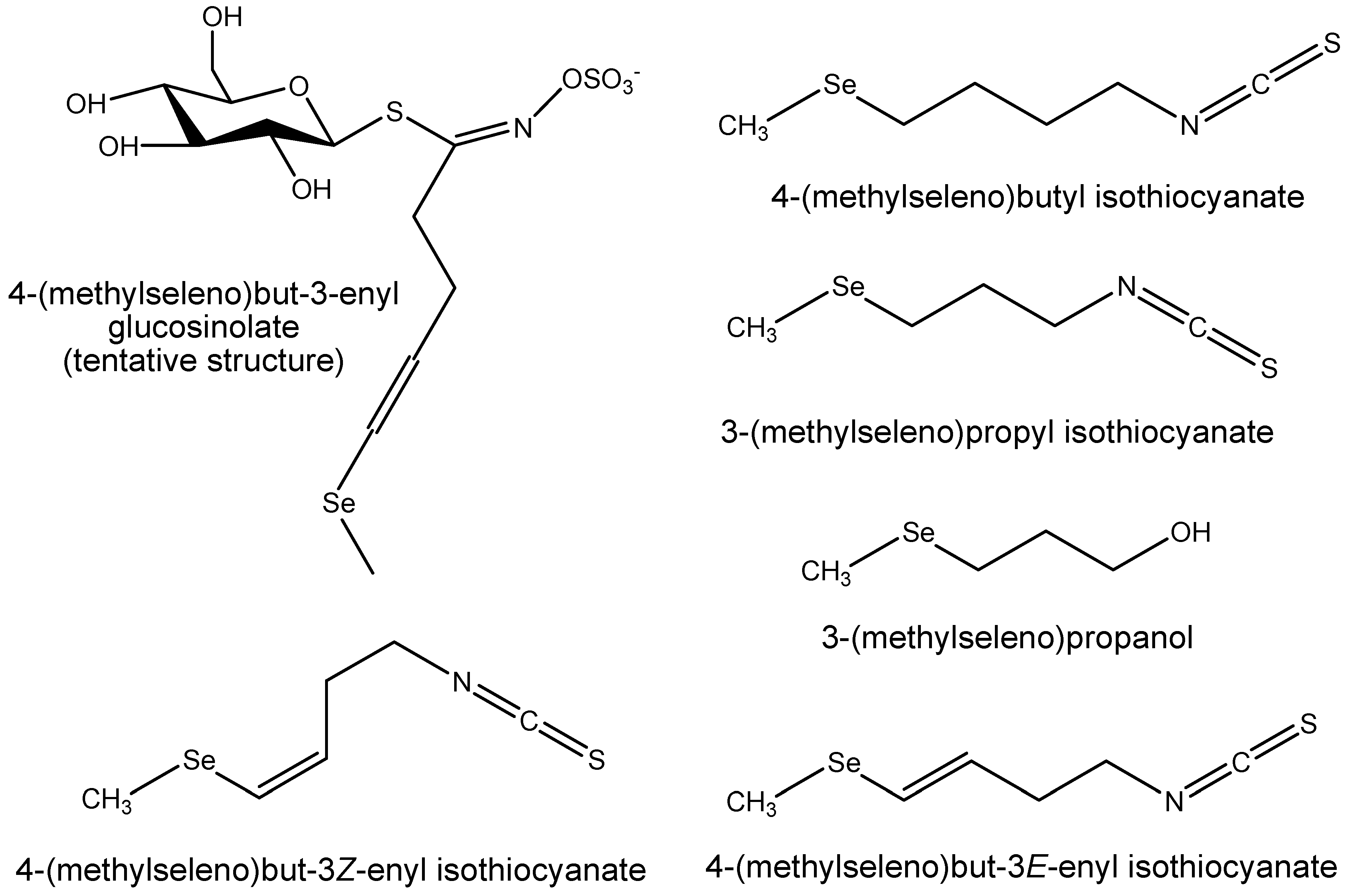
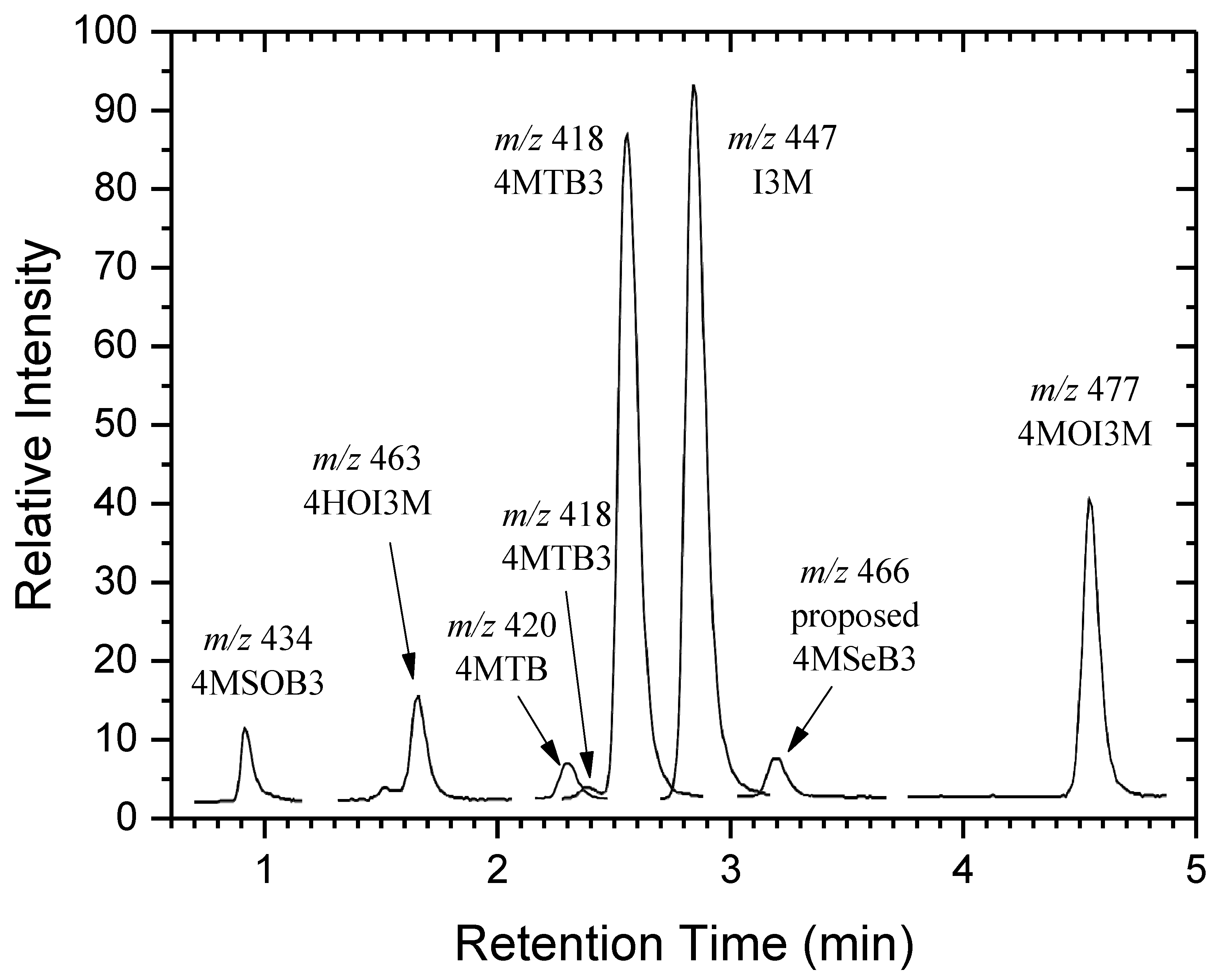
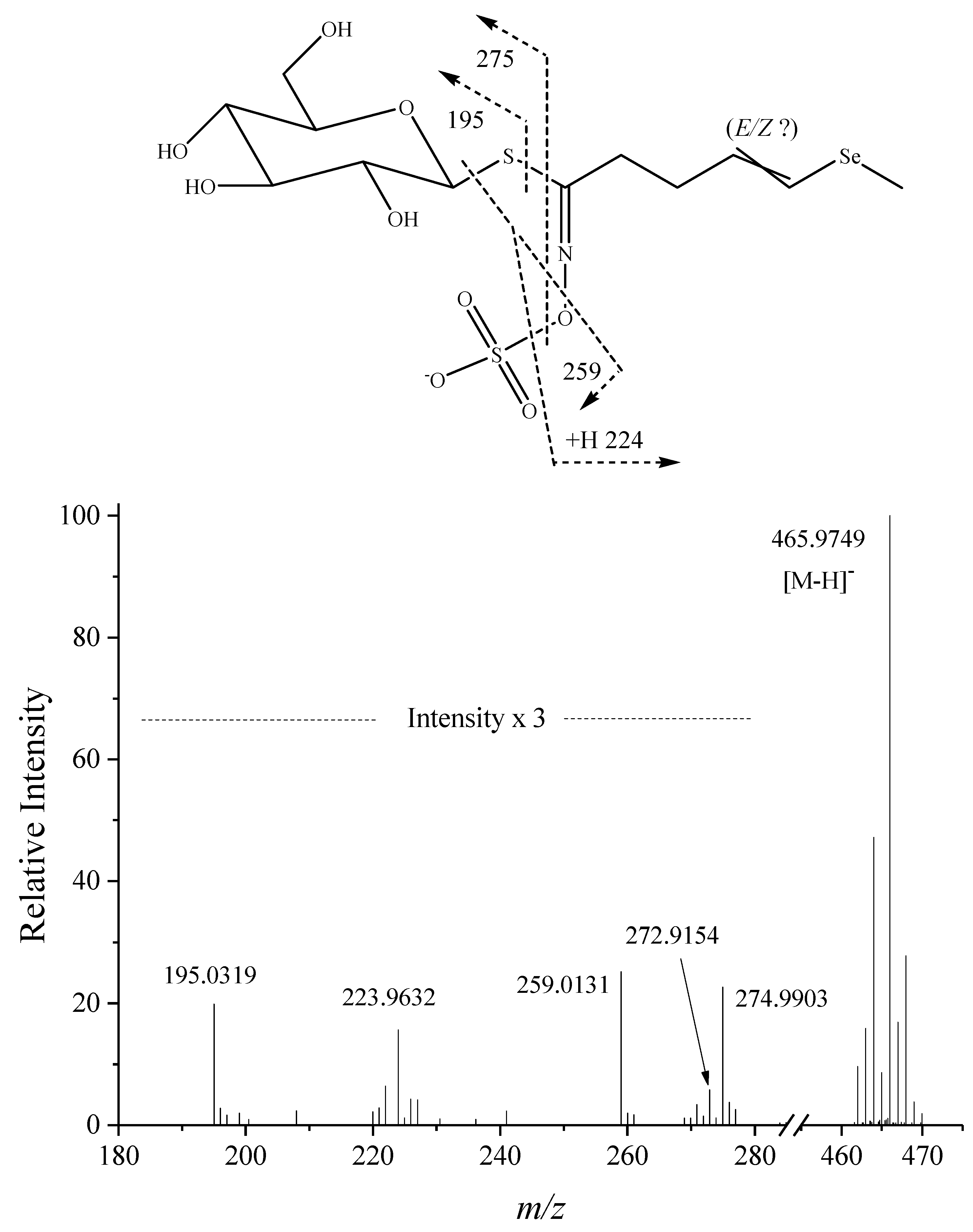
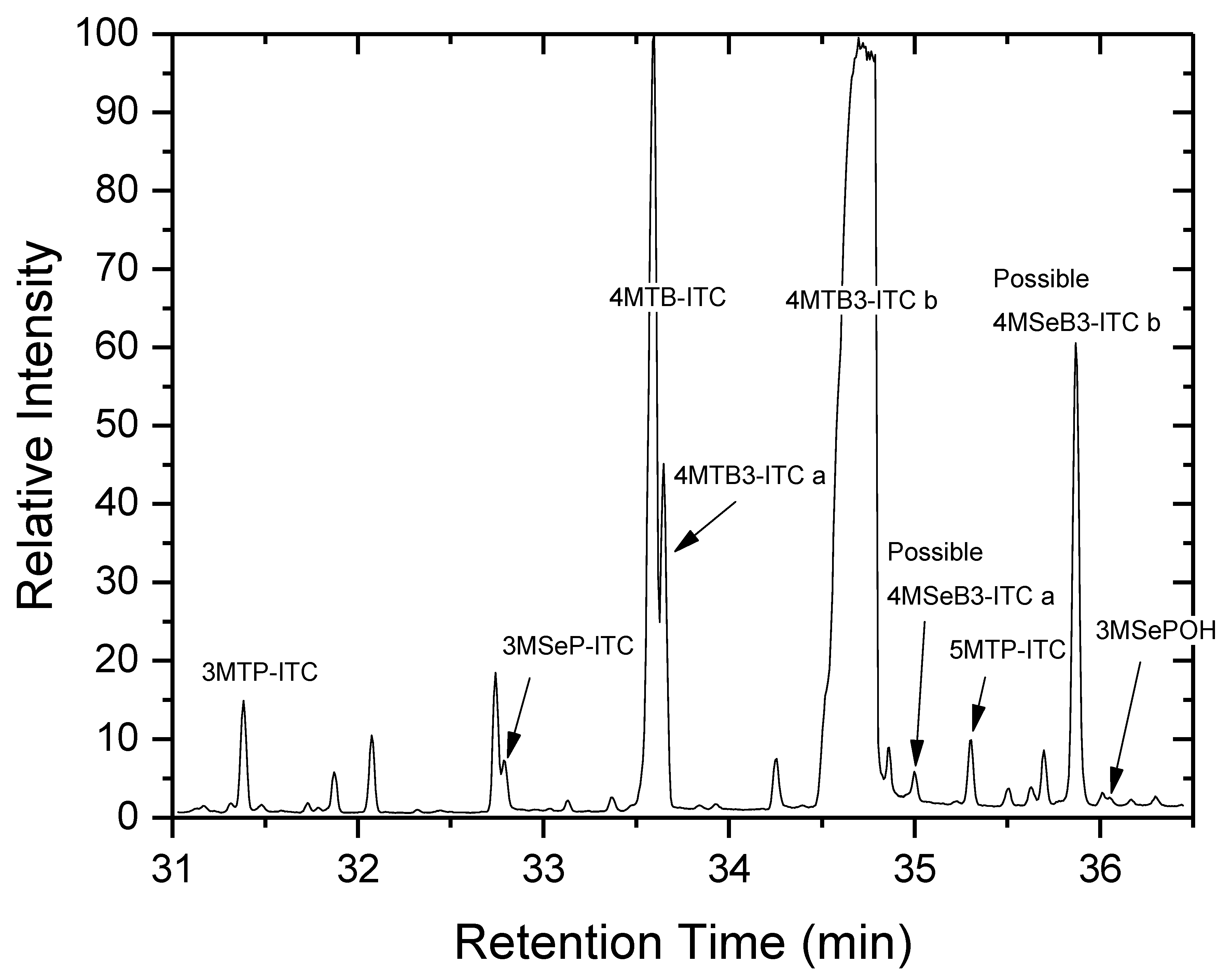
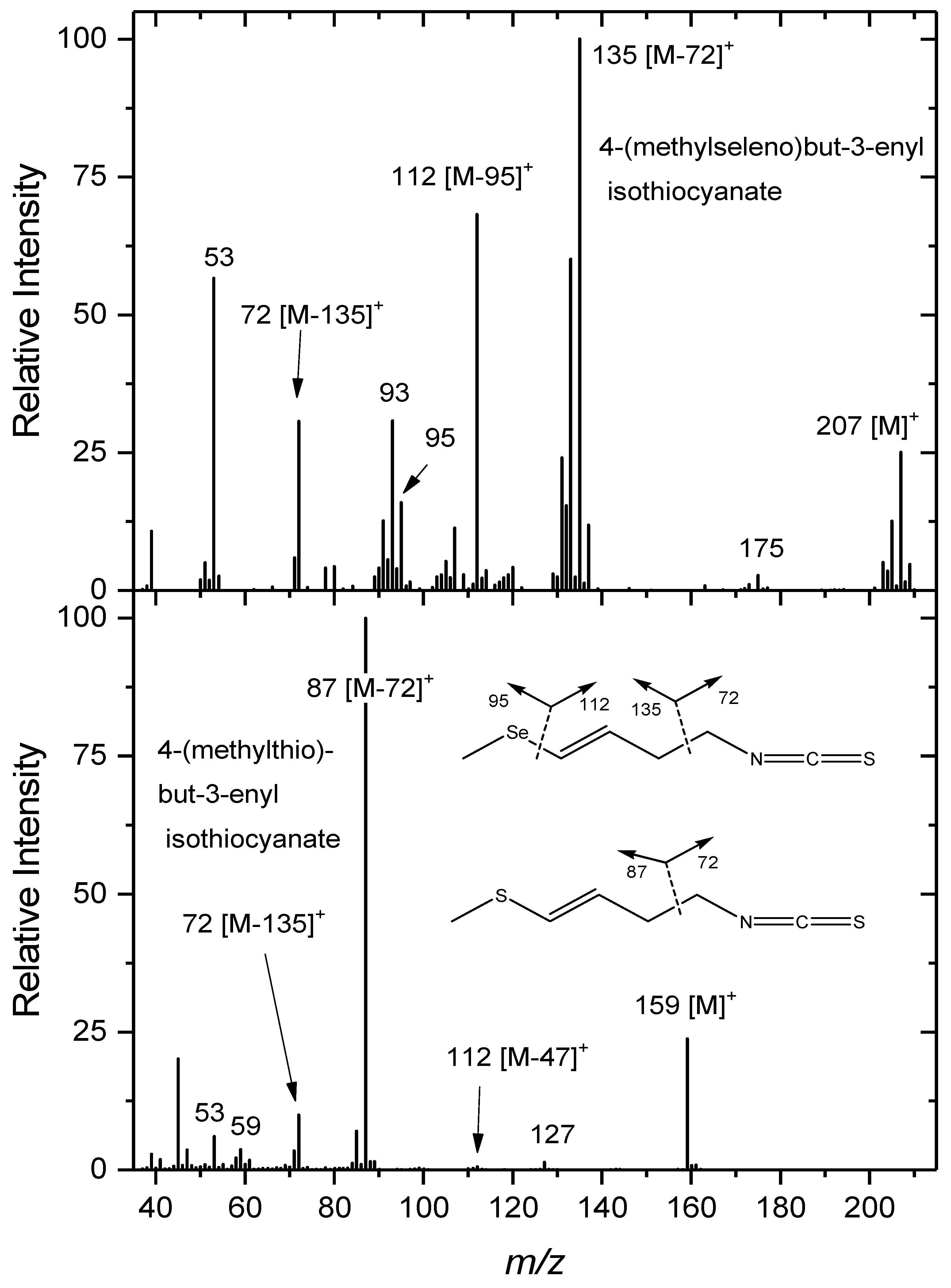
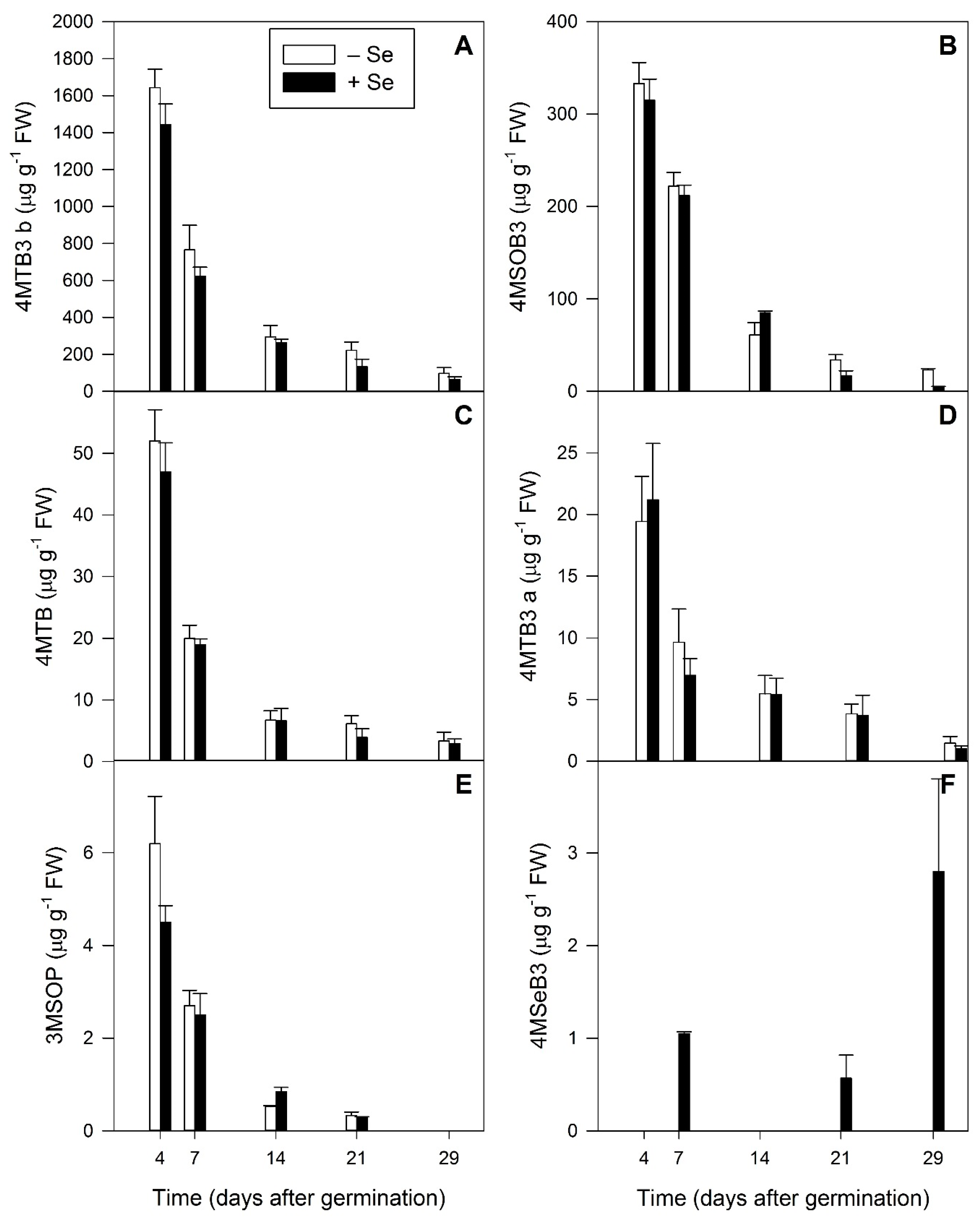
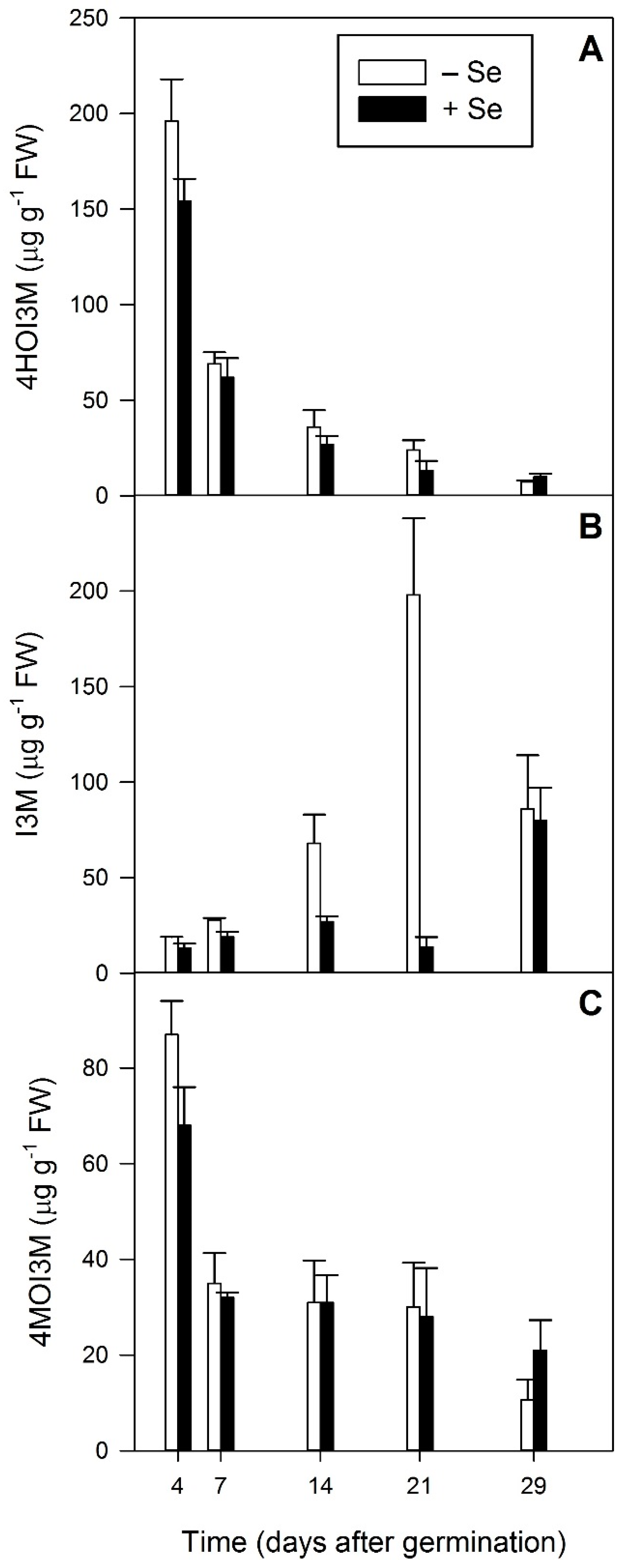
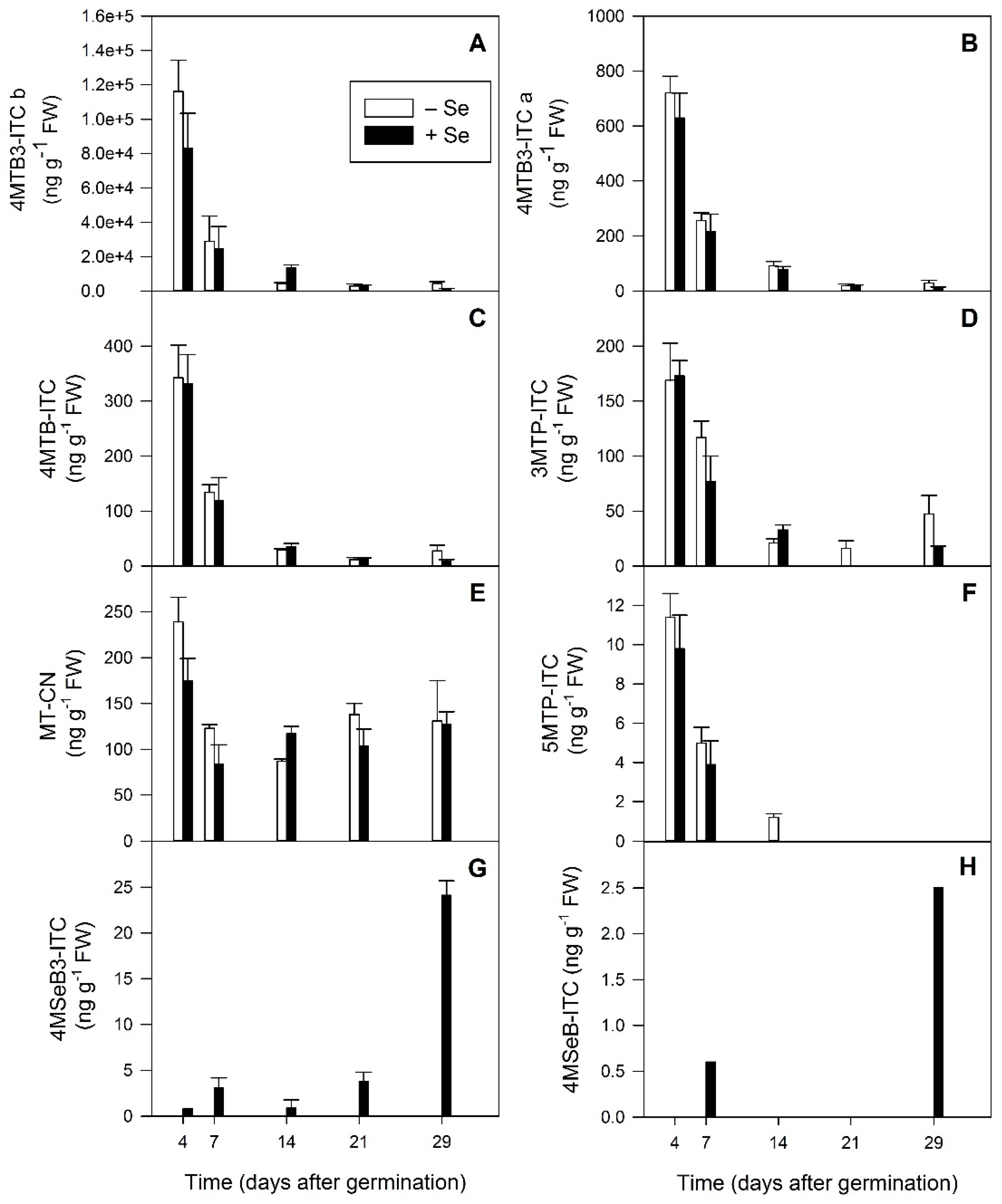
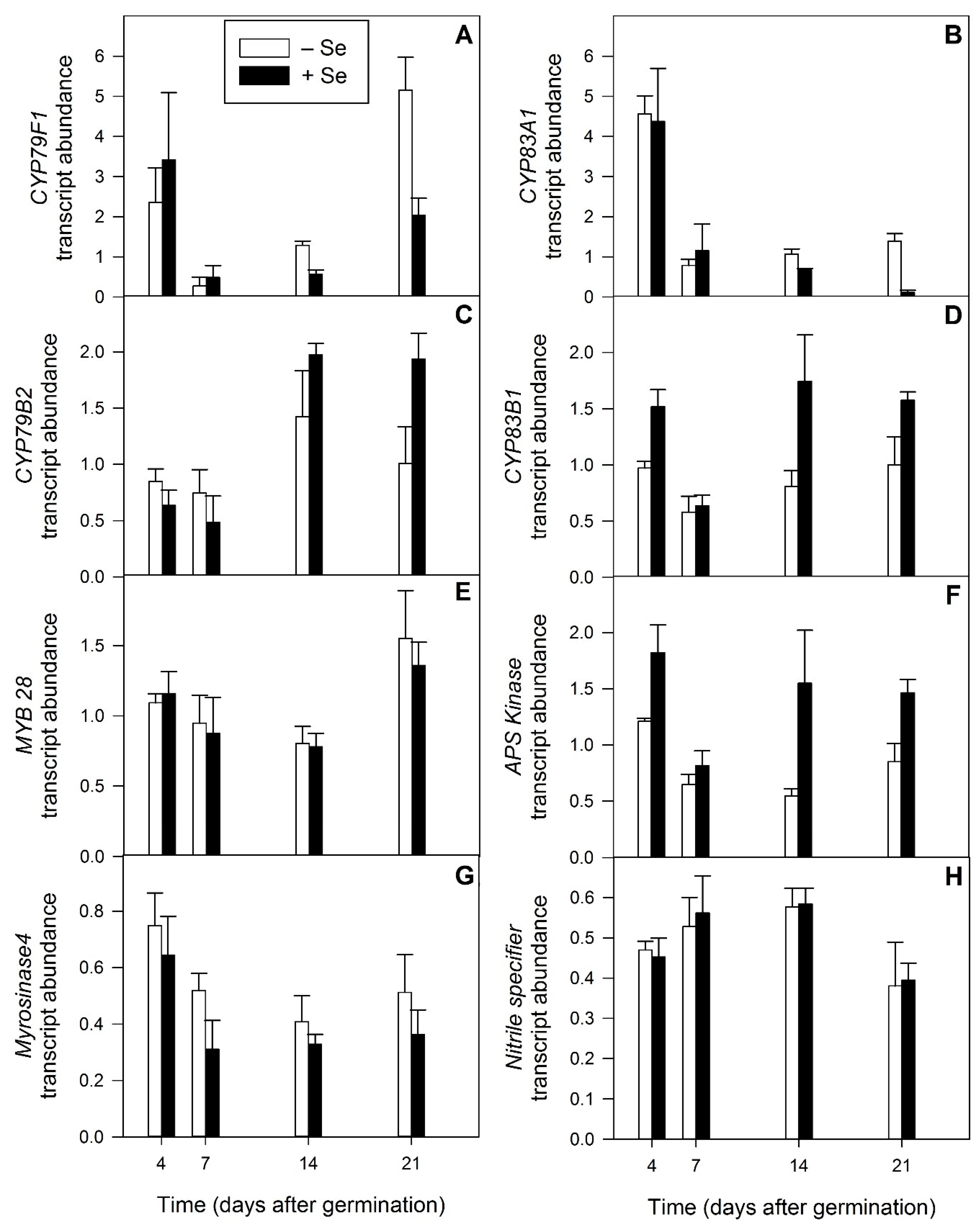
| Tissue Type | Source and Treatment | Total Se Content (µg g−1 DW a) |
|---|---|---|
| Seed | − Se seed b | 0.1 ± c 0.02 |
| Seed | + Se seed d | 174 ± 1.0 |
| Sprout e | − Se seed / − Se water | 0.21 ± 0.03 |
| Sprout | − Se seed / + Se water | 229.8 ± 20.9 |
| Sprout | + Se seed / − Se water | 187.1 ± 2.9 |
| Sprout | + Se seed / + Se water | 335.0 ± 32.0 |
| (µg g−1 FW a) | Seed Source b | Sprout Source c | ||||
|---|---|---|---|---|---|---|
| Glucosinolate | − Se seed | + Se seed | − Se seed − Se water | − Se seed + Se water | + Se seed − Se water | + Se seed + Se water |
| 4MSOB3 | 1097.0 | 1696.0 | 676 ± d 45 | 708 ± 43 | 713 ± 55 | 721 ± 139 |
| 4MTB3 b | 81.0 | 177.0 | 308 ± 50 | 248 ± 23 | 269 ± 37 | 231 ± 57 |
| 4MTB | 16.3 | 26.6 | 14.3 ± 1.5 | 13.2 ± 1.4 | 16.0 ± 2.0 | 15.0 ± 3.6 |
| 4MTB3 a | 4.5 | 9.7 | 3.7 ± 0.4 | 4.17 ± 0.59 | 7.0 ± 1.1 | 6.64 ± 0.75 |
| possible 4MSeB3 | nd e | 7.8 | nd | nd | 2.9 ± 0.2 | 2.7 ± 0.7 |
| Total glucosinolates | 1198.8 | 1917.1 | 1002 ± 96.9 | 973.4 ± 67.9 | 1007.9 ± 5.3 | 976.3 ± 2010 |
| Compound (µg g−1 FW a) | Seed Source b | Sprout Source c | ||||
|---|---|---|---|---|---|---|
| − Se seed | + Se seed | − Se seed − Se water | − Se seed + Se water | + Se seed − Se water | + Se seed + Se water | |
| 4MTB3-ITC b | 0.07 | 2.6 | 283 ± d 155 | 151 ± 49 | 208 ± 7 | 208 ± 32 |
| 4MTB-ITC | 0.04 | 0.32 | 7.72 ± 3.25 | 2.47 ± 0.53 | 6.92 ± 0.43 | 5.5 ± 2.58 |
| 4MTB3-ITC a | 0.01 | 0.1 | 1.86 ± 0.35 | 2.09 ± 0.34 | 1.75 ± 0.24 | 1.26 ± 0.64 |
| 3MTP-ITC | nd e | 0.07 | 1.31 ± 0.1 | 1.56 ± 0.63 | 0.9 ± 0.08 | 0.67 ± 0.24 |
| 5MTP-ITC | nd | nd | 0.11 ± 0.02 | 0.12 ± 0.04 | 0.13 ± 0.01 | 0.11 ± 0.01 |
| possible 4MSeB3-ITC b | nd | 0.04 | nd | nd | 1.08 ± 0.08 | 1.05 ± 0.11 |
| 3MSeP-ITC | nd | 0.013 | nd | nd | 0.14 ± 0.01 | 0.13 ± 0.01 |
| possible 4MSeB3-ITC a | nd | nd | nd | nd | 0.05 ± 0.001 | 0.04 ± 0.006 |
| 3MSePOH | nd | nd | nd | nd | 0.03 ± 0.003 | 0.09 ± 0.01 |
| 4MSeB-ITC | nd | nd | nd | nd | 0.01 ± 0.001 | 0.01 ± 0.001 |
| Total aglycons | 0.12 | 3.14 | 294 ± 159 | 157 ± 50 | 219 ± 7.9 | 216 ± 36 |
© 2019 by the authors. Licensee MDPI, Basel, Switzerland. This article is an open access article distributed under the terms and conditions of the Creative Commons Attribution (CC BY) license (http://creativecommons.org/licenses/by/4.0/).
Share and Cite
McKenzie, M.; Matich, A.; Hunter, D.; Esfandiari, A.; Trolove, S.; Chen, R.; Lill, R. Selenium Application During Radish (Raphanus sativus) Plant Development Alters Glucosinolate Metabolic Gene Expression and Results in the Production of 4-(methylseleno)but-3-enyl glucosinolate. Plants 2019, 8, 427. https://doi.org/10.3390/plants8100427
McKenzie M, Matich A, Hunter D, Esfandiari A, Trolove S, Chen R, Lill R. Selenium Application During Radish (Raphanus sativus) Plant Development Alters Glucosinolate Metabolic Gene Expression and Results in the Production of 4-(methylseleno)but-3-enyl glucosinolate. Plants. 2019; 8(10):427. https://doi.org/10.3390/plants8100427
Chicago/Turabian StyleMcKenzie, Marian, Adam Matich, Donald Hunter, Azadeh Esfandiari, Stephen Trolove, Ronan Chen, and Ross Lill. 2019. "Selenium Application During Radish (Raphanus sativus) Plant Development Alters Glucosinolate Metabolic Gene Expression and Results in the Production of 4-(methylseleno)but-3-enyl glucosinolate" Plants 8, no. 10: 427. https://doi.org/10.3390/plants8100427
APA StyleMcKenzie, M., Matich, A., Hunter, D., Esfandiari, A., Trolove, S., Chen, R., & Lill, R. (2019). Selenium Application During Radish (Raphanus sativus) Plant Development Alters Glucosinolate Metabolic Gene Expression and Results in the Production of 4-(methylseleno)but-3-enyl glucosinolate. Plants, 8(10), 427. https://doi.org/10.3390/plants8100427





